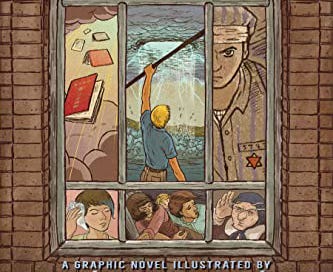Most people still associate graphic novels with kids and teens, even though the Jewish Comics Library of Seattle is largely an adult collection. That irony isn’t lost on us. But every once in a while, a set of books reminds us why comics for middle school readers matter, especially when they take on the heavy themes of Jewish identity, history, and even the Holocaust, through the imaginative lens of fantasy.
Three books, all published within the last five years, are in our collection and stand out as bold examples of how fantasy can help younger readers confront deep truths. Each blends folklore, magic, and myth with a distinctly Jewish sensibility, offering age-appropriate but powerful ways to explore who we are and where we come from.
Courage to Dream: Tales of Hope in the Holocaust by Neal Shusterman (with artwork by Andrés Vera Martínez) is a genre-bending anthology that dares to imagine magical resistance in the face of historical trauma. Shusterman uses surrealism, allegory, and fantasy to explore survival and defiance during the Shoah. It’s not an easy book—but it’s the kind that sticks, opening space for conversation and reflection.
Ben Mortara and the Thieves of the Golden Table by Arnon Z. Shorr is an action-packed archaeological adventure featuring a Sephardic Jewish protagonist in the mold of Indiana Jones. Beyond the swashbuckling thrills, it’s an invitation to explore lesser-known Jewish histories, proving that Jewish identity isn’t monolithic—and that it can fuel stories that are both entertaining and illuminating.
The Unfinished Corner by Dani Colman spins an original tale out of Jewish myth. When a Bat Mitzvah girl gets swept into a magical journey to the mythical “unfinished corner” of creation, she must face questions of tradition, obligation, and belief. It’s smart, funny, and deeply rooted in Jewish cosmology—and it doesn’t talk down to its readers.
These stories are part of a long lineage of folk tales and midrashic interpretive narrative. And writers like Isaac Bashevis Singer, who wrote for both adults and children, knew that fantasy was a necessary part of Jewish storytelling. His world was filled with dybbuks, golems, demons, angels, and devout fools—all standing in for the emotional and moral ambiguities of real life. Like Singer’s tales, these comics use the supernatural to express something deeply human: fear, hope, resilience, and the search for meaning.
So yes, most of our collection might be for grown-ups. But we’re proud to spotlight these middle-grade and YA works—and we have more—that use fantasy not to hide from the past, but to better understand it. These are stories that speak across generations and across the veil between the real and the imagined.








